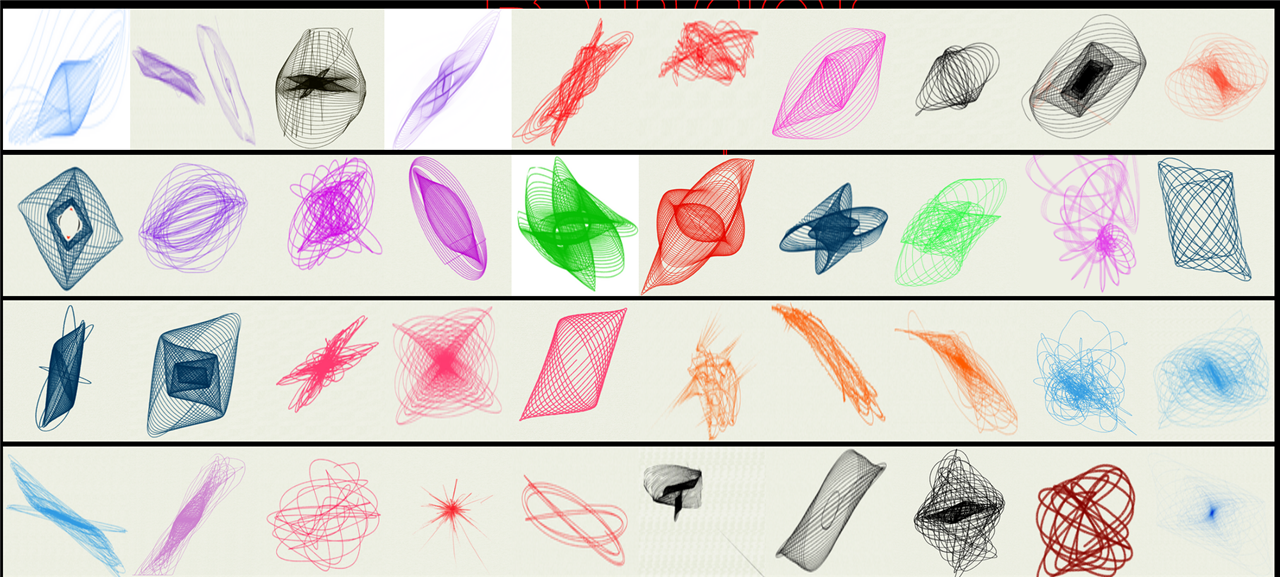The harmonographics project was a drawing machine using pendulums. A perhaps passe tik tok craze was to make pendulum art, but paint every place isnt my thing.
For the uninitiated:
A harmonograph is a mechanical apparatus that employs pendulums to create
a geometric image. The drawings it creates are called Lissajous curves. The
harmonograph was invented in 1844 by Hugh Blackburn, a professor of mathe-
matics at the University of Glasgow
Harmonographs can have many pendulums and axes interacting, but every version of harmonograph suffers from the same constraints: force, and overcoming drag.
Traditional harmonographs use mass and leverage to overcome drag
placed on a pen. This makes traditional harmonographs cumbersome, heavy, a
little bit hazardous. Everything from construction cost, to run time, to image
quality is effected by the amount of drag which must be overcome to produce
motion.
I didn't want to replicate any of that, so... what do?
Well, in an on going effort to figure it out, I ended up realizing how a drawing tablet / stylus work. The stylus is basically a transformer acting like an antenna. normal drawing with a stylus pushes the nib into the coil, like adding or removing the core of a transformer. With the nib fully inserted the stylus becomes a significantly better transformer. ordinarily, this would result in drag, and the eventual deterioration of the nibs. I just did not want the drag. So I used tape to force the nib into the stylus. Doing so allows the stylus to be detected at about an inch and a half away.
I experimented with drafting my own drawing program, but quickly realized there is quiet a bit of interpolation going on. The tablet produces pixels, rather than vectors, or continuous lines.
to avoid all that, I opted to use the Open Source drawing program MyPaint, which works great in linux, and was easily configurable to some specific settings related to this drawing machine.
I built a 18 inch square platform using 3D printer parts, and 4, 26 segments of threaded rod. I mounted an electrical box cover plate on the top of the plywood covering the platform, and used magnets an string to create a pulley system to adjust the pendulum body. Placing the magnets in different positions, resulting in different lengths, and angles, produces different chaotic motions. I made an acrylic pen holder, but that was ultimately replaced with a piece of metal I found in a dumpster. This meant I could use 3 magnets on each pendulum, and adjust their height, and placements in 3 positions each. I also added some bolts loaded up with nuts to allow mass to be added in various ways, to effect efficiency and run time of the harmonograph.
I placed the Drawing tablet below the pendulum, and a computer running myPaint, on the upper platform.
Then I created a little remote console with a clear, and save button. I used a teensy 3.1, with a RTC module to generate time stamps. The computer was a file server, with NGINX running, so I wrote a line into the myPaint config file telling it to save to the appropriate location.
The Arduino Code would send key strokes to clear the screen, or save the current file with a timestamped file name.
This project went through several iterations, and was on display at the Bangor Makerspace from September 2022 to February 2024.
Here are some of the pictures drawn by various visitors:
The source code for the project is here:
https://pastebin.com/raw/Gi6dqpLd
And here is some unflattering photos of the harmonograph:
Some commercial harmonographs exist, I saw a kick starter for one. it works, and fails in the same way every other hamonograph fails, by physically dragging a stylus across a surface. Im biased of course, mine was light weight, portable, and significantly more efficient, without the need to be clamped to a desk. Realistically, even a commercial digital harmonograph could produce far better results by simply taping the nib of the stylus to be at maximum insertion, and thus, eliminating drag.
Other versions:
I made a version using fans to self start the chaotic motion. The fans where attached mid point in the pendulums, and in addition to having their own impulse motions, would also create fan turbulence, Very chaotic motion would soon ensue. unfortunately, I do not own a drawing tablet large enough to encompass the area this type of pendulum would move in.
Can't all of this be done with parametric equations on a computer?
Yeah, sure. but lame.

Top Comments
-

DAB
-
Cancel
-
Vote Up
+1
Vote Down
-
-
Sign in to reply
-
More
-
Cancel
Comment-

DAB
-
Cancel
-
Vote Up
+1
Vote Down
-
-
Sign in to reply
-
More
-
Cancel
Children